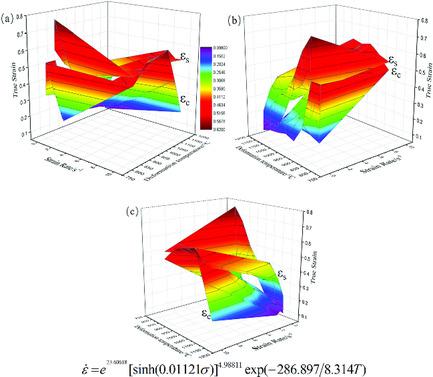当前位置:
X-MOL 学术
›
Steel Res. Int.
›
论文详情
Our official English website, www.x-mol.net, welcomes your
feedback! (Note: you will need to create a separate account there.)
Hot Deformation Behavior of V–Ti Microalloy Steels
Steel Research International ( IF 1.9 ) Pub Date : 2020-07-28 , DOI: 10.1002/srin.202000225 Wenming Xiong 1, 2 , Renbo Song 1 , Ping Yu 1 , Zhijun Liu 1 , Shuai Qin 1 , Yingchao Zhang 1 , Shuyi Quan 1 , Weifeng Huo 1 , Zhiyang Zhao 1 , Shengrui Su 1 , Chen Wei 1
Steel Research International ( IF 1.9 ) Pub Date : 2020-07-28 , DOI: 10.1002/srin.202000225 Wenming Xiong 1, 2 , Renbo Song 1 , Ping Yu 1 , Zhijun Liu 1 , Shuai Qin 1 , Yingchao Zhang 1 , Shuyi Quan 1 , Weifeng Huo 1 , Zhiyang Zhao 1 , Shengrui Su 1 , Chen Wei 1
Affiliation

|
Hot deformation behavior of V–Ti microalloyed steel is carried out using Gleeble1500. The results show that the flow stress curve is mainly characterized by work hardening and high‐temperature deformation softening mechanisms. Herein, the combination of strain hardening rate–stress curve and stress–strain–temperature dynamic recrystallization 3D model can be used to determine the temperature and strain corresponding to the beginning and end of dynamic recrystallization. The recrystallization activation energy and hot deformation constitutive equation are calculated by austenite recrystallization kinetic regression. Comparing three constitutive equation models with different fitting accuracies, the hyperbolic sine equation with fitting accuracy of 0.99178 is obtained, and the thermal deformation activation energy is determined to be 286.897 kJ mol−1. It is close to the self‐diffusion activation energy of austenite 281 kJ mol−1, so the rate control mechanism under this deformation condition is the dislocation climbing of diffusion control. The combination of the 3D model of dynamic recrystallization and the constitutive equation can not only obtain the flow stress curve under a certain deformation condition, but also obtain the structure evolution information. The mutual verification of the two makes it possible to study the hot deformation behavior under different deformation conditions more comprehensively.
中文翻译:

V-Ti微合金钢的热变形行为
V–Ti微合金钢的热变形行为是使用Gleeble1500进行的。结果表明,流变应力曲线的主要特征是加工硬化和高温变形软化机理。这里,应变硬化率-应力曲线和应力-应变-温度动态再结晶3D模型的组合可用于确定与动态再结晶的开始和结束相对应的温度和应变。通过奥氏体再结晶动力学回归,计算了再结晶活化能和热变形本构方程。比较三个具有不同拟合精度的本构方程模型,得到拟合精度为0.99178的双曲正弦方程,确定热变形活化能为286.897 kJ mol。-1。它接近于奥氏体281 kJ mol -1的自扩散活化能,因此在这种变形条件下的速率控制机制是扩散控制的位错爬升。将动态再结晶的3D模型与本构方程相结合,不仅可以得到一定变形条件下的流变应力曲线,还可以得到组织演化信息。两者的相互验证使得有可能更全面地研究不同变形条件下的热变形行为。
更新日期:2020-07-28
中文翻译:

V-Ti微合金钢的热变形行为
V–Ti微合金钢的热变形行为是使用Gleeble1500进行的。结果表明,流变应力曲线的主要特征是加工硬化和高温变形软化机理。这里,应变硬化率-应力曲线和应力-应变-温度动态再结晶3D模型的组合可用于确定与动态再结晶的开始和结束相对应的温度和应变。通过奥氏体再结晶动力学回归,计算了再结晶活化能和热变形本构方程。比较三个具有不同拟合精度的本构方程模型,得到拟合精度为0.99178的双曲正弦方程,确定热变形活化能为286.897 kJ mol。-1。它接近于奥氏体281 kJ mol -1的自扩散活化能,因此在这种变形条件下的速率控制机制是扩散控制的位错爬升。将动态再结晶的3D模型与本构方程相结合,不仅可以得到一定变形条件下的流变应力曲线,还可以得到组织演化信息。两者的相互验证使得有可能更全面地研究不同变形条件下的热变形行为。










































 京公网安备 11010802027423号
京公网安备 11010802027423号